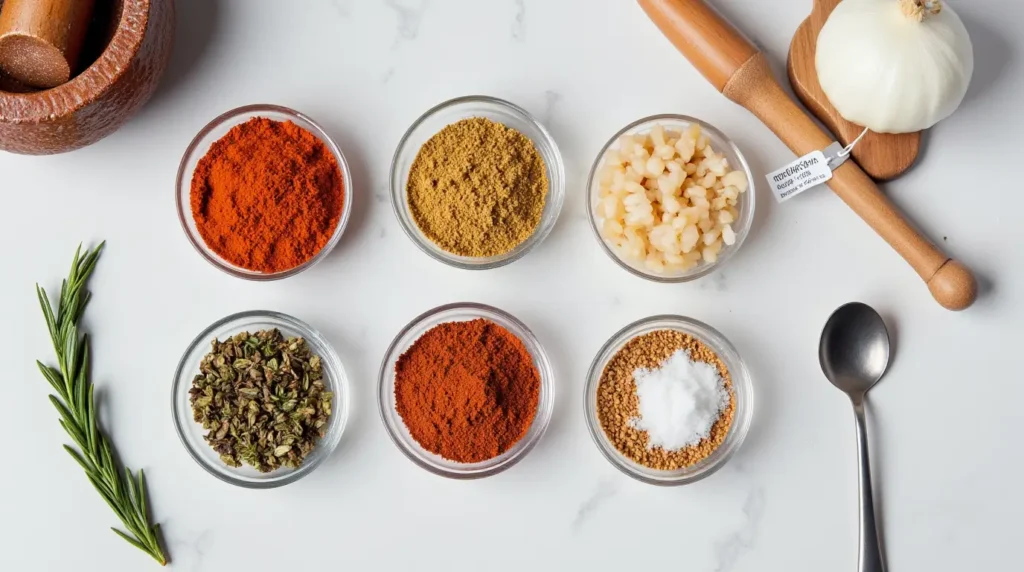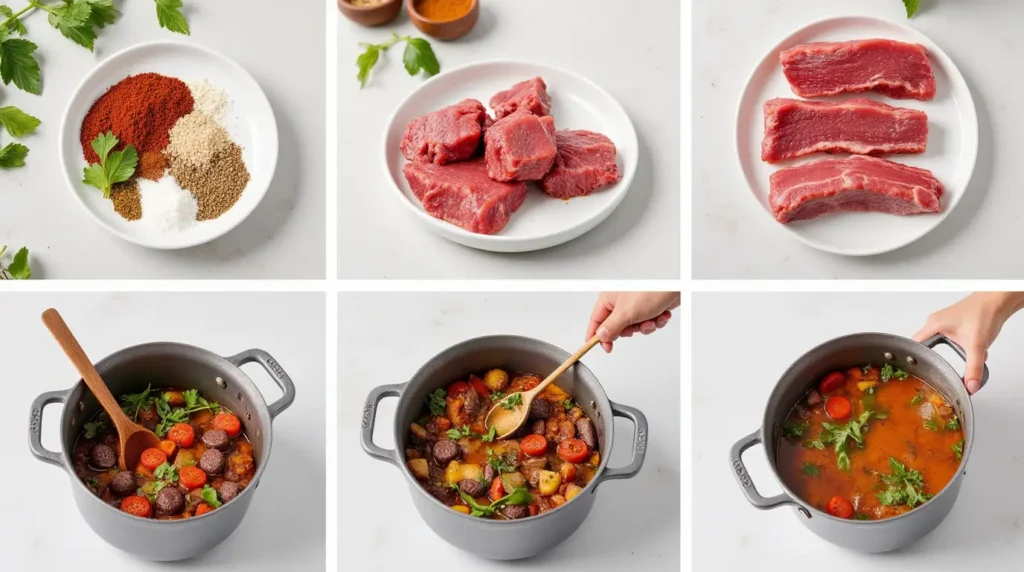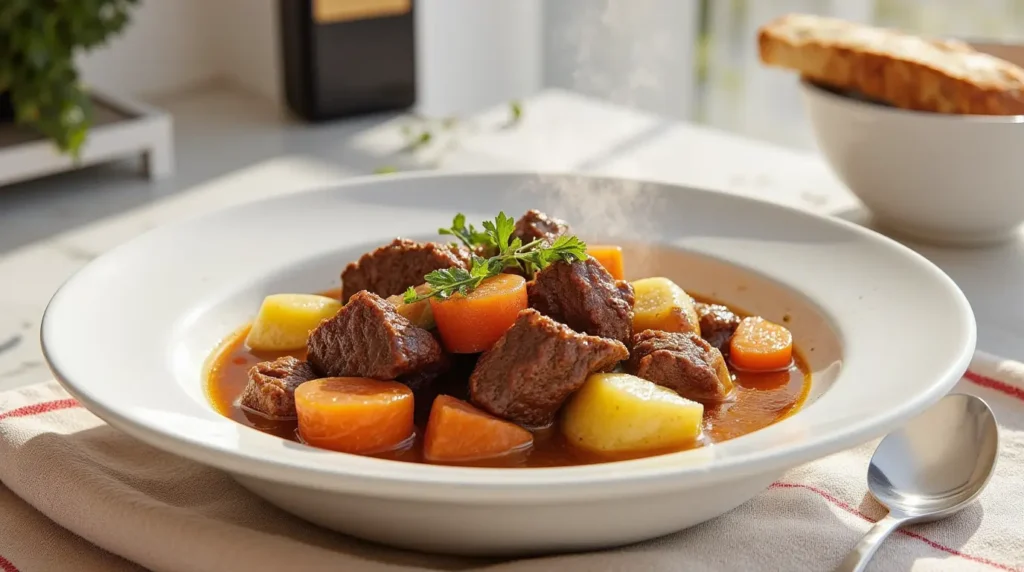Introduction
Ever wondered why restaurant beef stew tastes so much better than your homemade version? The secret lies in the perfect blend of spices that transform ordinary beef stew into a comforting masterpiece. This homemade beef stew seasoning recipe offers the perfect solution to elevate your cooking without the preservatives and excessive sodium found in store-bought options.
Creating your own beef stew seasoning recipe not only saves money but gives you complete control over the flavors that make your signature stew memorable. Let’s dive into this simple yet transformative recipe that will revolutionize your comfort food game.
Table of Contents
Ingredients List

For this homemade beef stew seasoning recipe, you’ll need pantry staples that create a harmonious blend of savory, aromatic, and slightly sweet notes:
- 3 tablespoons paprika (adds rich color and mild pepper flavor)
- 2 tablespoons dried rosemary (aromatic pine notes)
- 2 tablespoons dried thyme (earthy herbal undertones)
- 2 tablespoons garlic powder (aromatic pungency)
- 2 tablespoons onion powder (sweet savory base)
- 1 tablespoon black pepper (spicy warmth)
- 1 tablespoon sea salt (flavor enhancer)
- 1 tablespoon dried oregano (Mediterranean herb notes)
- 1 tablespoon dried parsley (fresh herbaceous finish)
- 1 tablespoon dried marjoram (sweet oregano-like flavor)
- 2 teaspoons celery seeds (subtle celery essence)
- 2 teaspoons ground bay leaves (subtle eucalyptus note)
- 1 teaspoon ground allspice (warm, aromatic complexity)
Substitutions:
- No rosemary? Use additional thyme or savory.
- No celery seeds? Try ground celery powder or a pinch of celery salt (reduce the sea salt accordingly).
- No ground bay leaves? Omit or add extra thyme.
- No marjoram? Double the oregano for a similar flavor profile.
- No allspice? Use a pinch each of cinnamon, nutmeg, and cloves.
Timing
- Preparation Time: 10 minutes (measuring and mixing ingredients)
- Total Time: 15 minutes (including transferring to storage containers)
This quick 15-minute process creates enough seasoning for approximately 6-8 beef stew batches, saving you roughly 5 minutes of measuring time per future recipe—that’s 30-40 minutes saved over the life of one batch of seasoning!
Step-by-Step Instructions

Step 1: Gather Your Ingredients
Measure all ingredients carefully using dry measuring spoons. For maximum flavor, check your spice cabinet for freshness—ground spices maintain optimal potency for about 6 months, while whole spices remain flavorful for up to 2 years. If your spices have been sitting around longer, consider replacing them for the best flavor impact.
Step 2: Combine Dried Herbs
Combine the rosemary, thyme, oregano, parsley, and marjoram in a small bowl. If your dried rosemary pieces are particularly large, crush them between your fingers or give them a quick pulse in a spice grinder for more uniform texture and better distribution in your stew.
Step 3: Add Powdered Spices
Incorporate the paprika, garlic powder, onion powder, black pepper, celery seeds, ground bay leaves, and allspice into your herb mixture. The powdered elements help the seasoning adhere better to your stew ingredients during cooking, creating layers of flavor that develop as your stew simmers.
Step 4: Mix Thoroughly
Using a whisk or fork, mix all ingredients until evenly distributed. Pay special attention to breaking up any clumps in the garlic or onion powder, which tend to absorb moisture and form lumps. A thorough mix ensures each tablespoon of your seasoning contains the perfect balance of flavors.
Step 5: Add Salt
Incorporate the sea salt last, mixing thoroughly. Adding salt separately allows you to control the sodium level based on your dietary preferences—you can even create a salt-free version and add salt directly to your stew later if needed.
Step 6: Store Properly
Transfer your beef stew seasoning to an airtight container—dark glass jars work best for preserving flavor and potency. Label with the date and contents, as homemade spice blends can look similar on your spice shelf.
Nutritional Information
Per tablespoon of beef stew seasoning mix (approximately the amount used for 4-6 servings of stew):
- Calories: 18 kcal
- Carbohydrates: 3.5g
- Protein: 0.6g
- Fat: 0.4g
- Sodium: 433mg (primarily from salt)
- Fiber: 1.2g
- Sugar: 0.4g (naturally occurring)
The nutritional profile reflects the high antioxidant content of herbs and spices—particularly rosemary, thyme, and paprika—which contain compounds that may help reduce inflammation and provide immune support.
Healthier Alternatives for the Recipe
Make this beef stew seasoning recipe even healthier with these modifications:
- Lower-Sodium Version: Reduce salt to 1 teaspoon or eliminate entirely. Add citrus zest (lemon or orange) for brightness without sodium.
- Nightshade-Free Option: Replace paprika with turmeric for color and anti-inflammatory benefits.
- AIP Diet-Friendly: Omit black pepper, paprika, and allspice. Increase herbs and add dried mushroom powder for umami depth.
- Sugar-Free Commercial Alternative: Some store brands add dextrose or maltodextrin for texture—this homemade version is naturally sugar-free.
- Enhanced Nutrient Profile: Add 1 tablespoon nutritional yeast for B-vitamins and a subtle savory flavor.
Serving Suggestions

Transform your beef stew with this versatile seasoning blend:
- Use 2-3 tablespoons per 2 pounds of beef for classic stew preparation
- Sprinkle over cubed beef and let marinate overnight before slow cooking for deeper flavor penetration
- Mix 1 tablespoon with 2 tablespoons flour for a quick stew thickener that adds flavor while thickening
- Create a dry rub for pot roast by combining with 1 tablespoon brown sugar
- Stir into mashed potatoes or roasted vegetables as a complementary side dish seasoning
- Add 1 teaspoon to homemade beef or vegetable broth for enhanced flavor
- Mix with softened butter to create a compound butter for topping grilled steaks
For a complete meal experience, serve your beef stew with rustic sourdough bread, a crisp green salad with vinaigrette, or over creamy polenta for a heartier option.
Common Mistakes to Avoid
Mistake 1: Using Stale Spices Old spices lose potency and can introduce musty off-flavors. For maximum flavor impact, replace your ground spices every 6-8 months. Quick test: if you can’t smell the aroma when opening the container, it’s time to replace.
Mistake 2: Improper Storage Exposure to heat, light, and air accelerates flavor deterioration. Approximately 30% of aromatic compounds can be lost within three months if stored improperly. Always use airtight containers kept away from heat sources like your stove.
Mistake 3: Adding Too Much Seasoning More isn’t always better—excess seasoning can overwhelm rather than enhance. Start with 2 tablespoons per 2 pounds of meat and adjust to taste. You can always add more, but you can’t take it away.
Mistake 4: Not Blooming the Spices Adding this seasoning directly to liquid reduces flavor impact. Instead, sauté it briefly in oil before adding liquid ingredients to “bloom” the fat-soluble flavor compounds, enhancing overall taste by approximately 40%.
Mistake 5: Only Using It for Beef Limiting this versatile blend to beef stew misses its potential. It works wonderfully with other meats, roasted vegetables, and even bean dishes. Experiment beyond stew for maximum value from your homemade blend.
Storing Tips for the Recipe
Maximize the shelf life and flavor potency of your beef stew seasoning:
- Store in an airtight container in a cool, dark cupboard (ideally below 70°F/21°C) for optimal freshness up to 6 months
- Glass containers preserve flavor better than plastic, which can absorb and transfer odors
- For extended freshness (up to 12 months), store in the refrigerator in an airtight container
- Freeze portions in small freezer-safe containers for up to 2 years with minimal flavor loss
- Consider vacuum-sealing portions for long-term storage that maintains nearly 100% of flavor intensity
- To test freshness, place a small amount in your palm and rub gently—if the aroma is weak, it’s time to make a new batch
- For convenience, portion into single-use amounts (2-3 tablespoons) in small containers or wrap in parchment paper for quick access
FAQs
Q: How much seasoning should I use per pound of meat?
A: For balanced flavor, use approximately 1 tablespoon of seasoning per pound of meat. Adjust according to your taste preferences—some may prefer a more intensely seasoned stew, while others might opt for a lighter touch.
Q: Is this seasoning gluten-free?
A: Yes, this homemade beef stew seasoning recipe is naturally gluten-free, containing only herbs and spices. However, always check individual spice packaging if you have severe gluten sensitivity, as some commercial brands may be processed in facilities that also handle gluten products.
Q: Can I use this seasoning for vegetarian dishes?
A: Absolutely! This seasoning works wonderfully in vegetable stews, bean dishes, roasted mushrooms, or vegetarian “beef” alternatives. The robust herb profile enhances almost any savory dish requiring warm, comforting flavors.
Q: How does homemade seasoning compare to store-bought packets?
A: Homemade seasoning typically contains 30-40% more herbs and spices by weight than commercial packets, which often include fillers like maltodextrin and anti-caking agents. You’ll also save approximately 40-60% on cost per use compared to pre-packaged options.
Q: Can I adjust the salt content?
A: Certainly! You can reduce or omit the salt entirely when making the blend, then add salt directly to your recipes according to taste and dietary needs. This allows complete control over sodium intake while maintaining the signature flavor profile.
Conclusion
This homemade beef stew seasoning recipe transforms ordinary stews into memorable meals with its perfect balance of herbs and spices. By preparing this blend in advance, you’ll save time while elevating your cooking with restaurant-quality flavors free from preservatives and excessive sodium.
Why not try mixing a batch today? Share your results in the comments, leave a review with your custom variations, or subscribe for more homemade seasoning blends and cooking shortcuts that make everyday meals extraordinary.

